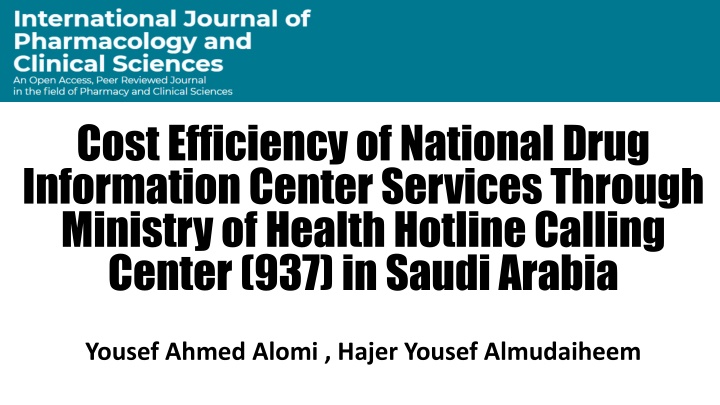
Cost Efficiency of National Drug Information Center Services in Saudi Arabia
Explore the cost avoidance analysis of national drug information inquiries through the Ministry of Health hotline in Saudi Arabia, emphasizing the importance and economic impact of drug information services.
Download Presentation

Please find below an Image/Link to download the presentation.
The content on the website is provided AS IS for your information and personal use only. It may not be sold, licensed, or shared on other websites without obtaining consent from the author. If you encounter any issues during the download, it is possible that the publisher has removed the file from their server.
You are allowed to download the files provided on this website for personal or commercial use, subject to the condition that they are used lawfully. All files are the property of their respective owners.
The content on the website is provided AS IS for your information and personal use only. It may not be sold, licensed, or shared on other websites without obtaining consent from the author.
E N D
Presentation Transcript
Cost Efficiency of National Drug Information Center Services Through Ministry of Health Hotline Calling Center (937) in Saudi Arabia Yousef Ahmed Alomi , Hajer Yousef Almudaiheem
ABSTRACT ABSTRACT: : Objective Objective: : Since January 2013, the national drug information center (NDIC) has started providing services and since December 2013, it is answering all the public and professional inquiries made through the Ministry of Health (MOH)- Hotline Calling Services (937). Therefore, in this study, we explored the cost avoidance analysis of national drug information inquiries by the hotline services in Saudi Arabia. Methods Methods: : We simulated the drug information inquiries related to the adults and children for the duration of 12 months of 2014 through MOH-hotline calling services (937). At least 10 on-call clinical pharmacists and expert trained pharmacists were receiving calls made from public and professionals inquiring about drug information. The data were collected in the drug information data collecting form through manual documentation system of drug information inquiries.
Results Results: : The drug information pharmacist implicated that the high-cost avoidance at the public side came from the dose standardization (30,310 USD (37.5%)) of the total cost avoidance followed by the drug administration and adverse drug reaction (16,532 USD (20.45%) and 9,347.5 USD (11.56%), respectively), which represent more than 50% of the total cost avoidance from the public side. With regard to professional inquiries, the drug information pharmacist implicated that the highest cost avoidance was through inquiries related to drugs in pregnancy, which was around 7,527.50 USD (26%) of the total cost followed by the drug administration, drug drug interaction and drug identification (4,792 USD (16.5%); 4,141.50 USD (14.3%); and 4,135.50 USD (14.2%), respectively), which represent more than 50% of the total cost avoidance from the professional side. Conclusion Conclusion: : NDIC was the first in calculating cost avoidance from answering drug information inquiries from professional and public separately in the Middle Eastern countries. It is highly implicated in the drug information services in the healthcare organization in the Kingdom of Saudi Arabia.
CONCLUSION CONCLUSION To the best of our knowledge, this is the first article to address cost avoidance classified by drug information inquiry for both public and healthcare providers; this shows the importance of having drug information in each hospital and the economic impact in just serving one task of DISs. This also sheds some light on how necessary and crucial is the documentation for each function as it does not only justify the services to get more support but also to monitor and improve it.
